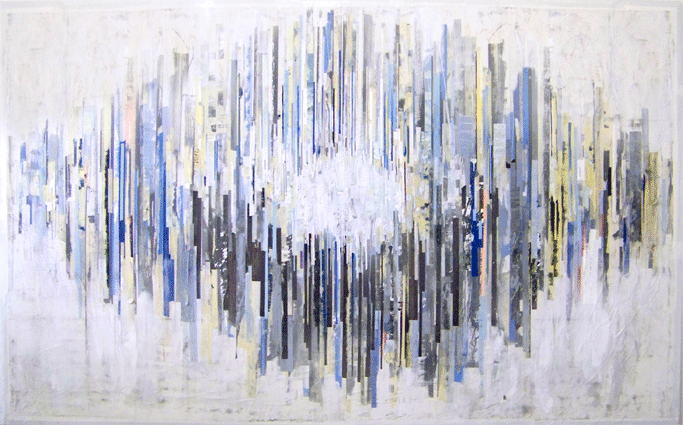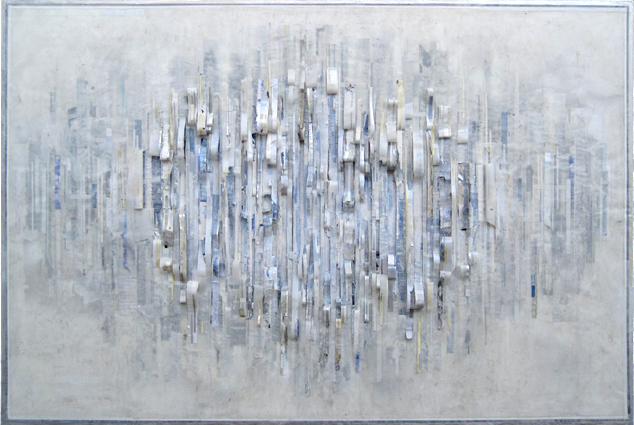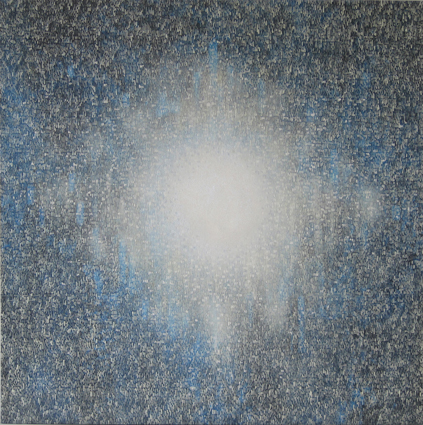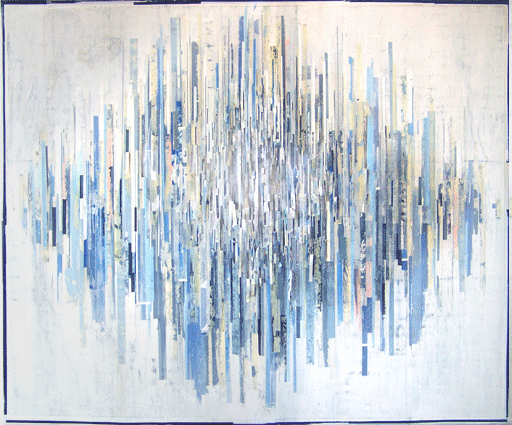Ryan Wallace is a painter and mixed media artist who lives and works in Brooklyn. His body of work spans a range of influences, re-purposing a variety of art historical and popular references into a fluid vocabulary of rough, playful abstraction. His paintings vary in size and medium but are united by their alternating notions of fragmentation and unity and by a moody, often diffuse tone. His compositions reflect the payload of modernism viewed through the dust covered lens of a gritty, sun bleached kaleidoscope. His interest in the way information is presented, transmitted and stored results in a sensibility that is equal parts science, mysticism and high fives. I had a chance to stop by the artists Greenpoint studio recently to talk with the artist.
HH: You went to school at RISD, your background is in illustration, have you always been a painter?
RW: I don’t have a deft touch. I have to work things into submission to gather my bearings. I tend to make a mess and then clean it up. There is room for this approach in painting. Painting has always felt most natural to me. I’ve been making sculptures and other three dimensional experiments lately but those even feel rooted in my approach to two-dimensional picture making. I stumble into these efforts as a result of not being able to articulate a tone or idea on a flat surface.
HH: You frequently work in the space between painting, collage and printmaking. Perhaps you can speak to this. How do different mediums fit into your practice?
RW: They all inform one and other. I’m always interested in finding new ways to use materials that are endemic to their specific properties. Certain types of work I can only resolve on paper, others on canvas or panel. The limitations of each lead to breakthroughs in others. In this sense the formal quality of materials is a very important part of my practice. I think I have a consistent sensibility and the outcomes are guided by the materials themselves. It keeps making things interesting. I couldn’t sit down and make ten paintings one at a time one after the other. While an oil painting is drying I may work on a mold for a sculpture or a piece on paper. It keeps the experience of being in the studio feeling fresh. I am free to work on what feels appropriate at the time. I think it also keeps a thread between the variety of media within a body of work.
HH: You are constantly working on several bodies of work, each embodies a separate formal element of your practice. Your make collages, what you termed “proper oil paintings,” spare minimal “tablet” paintings, as well as evocative unique prints, how do you imagine each as part of the whole?
RW: I see it all as one body of work composed in parts revealed at various times. I have mentioned before Brian Eno’s idea of a song as a selection lifted from a larger soundscape. I see my work functioning like this as well. That each piece is a selection of a larger atmosphere or timeline. Sometimes these parts are ripped from this environment and sometimes taken as an elegant slice or section. Certain paintings seem to be disintegrating or building themselves in front of you. Lately I have been looking at the Timeline pieces functioning like an Atlas and the other works as specificities within this larger collection. Atlas is also the name of particle detector at CERN that I have done research on. I like when monikers fall into place like that and this is often how I come to title works. In regards to my last show. I started the (((Ω.))) paintings in the summer of 2009. I developed them to a certain point then I photographed them and put them away for a year or so. Then, I bitmapped and tweaked the pictures in Photoshop and made lithography plates from those images. These plates became the basis for the works in the large square grid in the show. As I began those works on paper, I switched from newsprint to a finer, whiter drawing paper and Mylar to catch the run off from the plates in the printmaking process. Those pieces of paper and Mylar make up the cut pieces in Mist (Timeline) 3 and other works with the collage elements. Then I looked at everything and went back to finish the paintings that I had first started. From there I felt that the gestures in the work could be played with in a different way and maintain a similar tone and the Tablet paintings are the result of that exploration. So there is a physical and material relationship between the work as well as a conceptual link.
HH: Your collage pieces especially are defined by their use of form, there are clearly references to painterly tradition and modernism, but you draw equally from science. Where do you gather these influences?
RW: I read a lot of books and magazines, I attend seminars from time to time. Youtube and the web are valuable resources for research.
Right now I’m watching this:
http://www.wimp.com/bighistory/
I focus less on specificity and more on the gesture of these types of ideas. I am especially interested in the human condition, how we operate, perceive and interpret the world around us. I see a parallel between our own personal fears and desires and the way that the public views developments and trends in the sciences. The fuzziness of reality and imagination.
I recently read an article in Discover about how teams at the University of Rochester and University of Illinois at Urbana-Champaign were having success with a series of quantum experiments showing that measurements performed in the future can influence the present. They call this Reverse Causality. Destiny is another more familiar word. They were studying this by observing particles under a laser run through several mirrored reflections, over a prolonged period of time, much longer than is typical in these types of experiments. I saw this as a very similar approach to making a painting. You sit and observe and wait for things to happen in front of your stare and you go back, revisit marks and areas and make necessary adjustments. My work isn’t about the science of Reverse Causality. I will tap into an idea like this in terms of its approach to observation and time and philosophical nature and use that as a starting point for my work. Science has given me a lot of starting points in recent years.
What I find fascinating or worth further research isn’t important to the work beyond getting me to begin it. I am just trying to make pictures that contribute to the dialogue of painting. I see each piece as “a painting” not a painting about this or that.
HH: When did you start using collage, how do you approach this process?
RW: I have always made collages. As far as how I apply it now it began by wanting edges harder than I could make with paint. I was cutting out images and shapes from paper to get this type of edge and collaging those pieces into narrative, architectural paintings. As the work began to abstract more and more I still had these piles of cut paper and mylar laying around. Some pieces were of recognizable things and some were just scraps with color and texture that I had built up. I shared a studio at the time with the artist Joseph Hart. He uses cut paper and collage as a primary method in his work. He moves the pieces around on the page and makes malleable compositions that he plays with until they are glued down. I found this technique to be a fast way to find surprising results that I employed in my own work. Having this detritus around I was able to experiment with familiar material during this period of transition.
HH: Your paintings reference both the celestial and the grid, is there a logical intersection for the magical and the rational?
RW: When I present a piece like (((Ω.))) Cycle,
http://www.ryanmwallace.com/Guerrero8.html
those are the precise kinds of concerns that I am hoping to incite within the viewer. I try and keep any opinion out of the work but use materials and visual cues to guide its reception.
HH: Your works seem to champion a level of instability; there is a sense of both momentum and collapse. There is something dystopic, though your paintings are composed of light there is darkness, where do you fit in this contradiction?
RW: The notion of serenity subverted is a common theme. This brings us back to the blur and fuzziness of perception that I am interested in. With those paintings, I am aware that they reference Ross Bleckner’s light paintings at the same time as aboriginal dot paintings. The big bang and the big crunch. This white light is our symbol of creation and of death. I like the ambiguity of all of this. I think it breathes mystery into works that at first glance feel so direct. I find that it helps the viewer come to the work on their own terms.
HH: The introduction to your recent catalogue quotes Pierre Chardin. Can you elaborate on the significance of “the omega”?
RW: The Omega Point is a term that he coined in his book The Phenomenon of Man. Chardin’s theoretical “Omega Point” describes evolution as a process that leads to increasing complexity, culminating in the unification of consciousness. While I find these types of theories beautiful I am wary of lofty singular ideas and predictions: the end of the world, a raison d’etre for evolution, one supernatural being, universe, politic, etc. The nature of this singular event is subverted by painting more than one.Here is total consciousness….wait, maybe it’s this one.
I used this idea as the starting point for works in a recent solo show at Guerrero Gallery in San Francisco. A critic wrote this about this installation:
http://www.ryanmwallace.com/Guerrero1.html
“This visual reverie is interrupted in the installation by the sheer repetition of nearly identical canvases in tight proximity to each other. The frequency seemingly degrades the potency of each piece, shifting the interpretation of the sequence of paintings to the act of repetition itself. Robbed of this perceptual intimacy, the series as a whole shifts to a veneer of pop decadence, as if the canvases were nightclub promotions.”
He really understood what I am doing, though I’m not sure that he realized it. I found this very complimentary, I think it was meant to be critical.
HH: We’ve talked about your influences, from sci-fi to physics. Who are some of the contemporary artists you’re looking at today? Is there anyone who you feel pushes you?
RW: I find the artists closest to me to be the biggest inspiration.
Last week the best shows that I saw were by Mark Grotjahn, Picasso, Sol Lewitt and Katy Moran.
Tara Donovan’s show of pin paintings at Pace was exceptional as was the recent Rudolf Stingel show at Gagosian.
HH: Your starting a gallery in East Hampton, tell us a little bit about it.
RW: It is called Halsey Mckay Gallery and we are now open. The name is a combination of our grand mothers maiden names. Mckay is also my middle name. I opened it with my good friend Hilary Schaffner. She is an artist and in recent years has focused more on curatorial endeavors. She has a strong background in photography so between the two of us we have a pretty thorough appreciation of a broad spectrum of work. We are working with several artists but for the main exhibition area of the gallery we are focusing on one and two person shows. You can see images of our first show by Patrick Brennan here:
We are really excited to bring artists that we are close with and whose work we believe in to the Hamptons where there is a great understanding, history and support for visual art. It all happened very quickly and I feel very fortunate to have such amazing artists to give opportunities to and a great space to show the work in. The artists that we have in our schedule are truly emerging. They are all showing in New York and abroad and have exciting careers but may not have appeared in a biennial or major museum show yet. We are hoping to be able to exhibit these artists work in a setting that doesn’t have all of the pressure of a big New York show but still is exposed to serious patrons, artists and those who appreciate great work. The community in East Hampton can provide this.
HH: What are your plans? Upcoming shows?
RW: It’s a busy summer that I am really excited about.
I will be in Grasping for Relics at Zieher Smith organized by Patrick Brennan.
Summer Whites at Rachel Uffner curated by Eddie Martinez and Sam Moyer.
I’m releasing a book that I made with Oakland publisher Land and Sea at my friend Annabelle’s shop on June 17th. This is a joint release along with beautiful books made by Dave Kennedy Cutler and Ruby Sky Stiler.
I will be in a show at Blackburn 20/20 as part of a fellowship that I did at Robert Blackburn Printmaking Workshop.
I am curating a show at Eric Firestone Gallery in East Hampton called Domestic Goods. May 28-June 28. This is a large group show of some of my favorite people and artists.
At Halsey Mckay we are putting on five exhibitions from the end of May through September:
Patrick Breannan May 20-June 7
Joseph Hart & Ruby Sky Stiler June 10-July 4
Chris Duncan July 8-July 31
A Group show curated by Rachel Uffner August 5- September 6
Glen Baldridge & Bryan Graf September 6-October 3







 RSS
RSS
